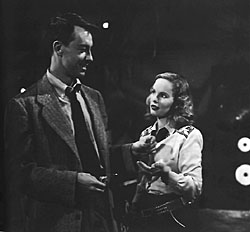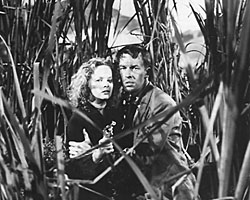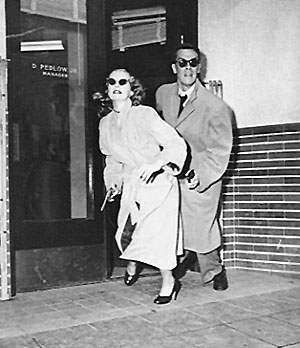|
Poor Bart. He's got a thing for guns and when he meets a woman who loves guns also, he's smitten for life. But as the carnival clown tells him: "Some guys are born smart about women and some guys are born dumb . . . You were born dumb." And thus starts his downward spiral in one of the greatest B movies ever made, Gun Crazy. Directed by Joseph H. Lewis, Gun Crazy is anything but typical film noir. It's a stylish, exhilarating rush of startling camera work and amazing characterizations. Its audacious visual style makes Gun Crazy as fresh today as it was nearly fifty years ago.
And the story is quintessentially American--a Bonnie and Clyde-like saga of two lovers who go on a robbery spree across several states. Bart and Annie Laurie Starr first meet at a carnival. He's fresh out of the Army, where he tired of the routine. Back in his hometown, he's taking in the carnival with his two old school chums, when they stop at a sideshow shooting exhibition. And Laurie struts forward onto the stage, dressed in a cowgirl outfit and firing her pistols--pow! pow! pow!--over her head. Sparks fly from the pistols and smoke curls toward the ceiling. She sees Bart in the first row, and her eyes eagerly size him up, head to toe, the way a sailor on leave might size up a woman at a bar. And she grins--a delicious, devious grin--that suggests she'd just love to eat him all up. Bart watches from the edge of his chair, rapt and already in love as she performs her shooting tricks.

Bart and Laurie meet during her shooting exhibition at a carnival.
He jumps at the chance to join her on stage in a shooting match. They prowl around one another like two dogs sniffing out each other's goods. In an interview with Danny Peary (Cult Movies, New York: Delacorte Press, 1981), director Lewis revealed his instructions to actors John Dall (Bart) and Peggy Cummins (Laurie Starr):
I told John, "Your cock's never been so hard," and I told Peggy, "You're a female dog in heat, and you want him. But don't let him have it in a hurry. Keep him waiting." That's exactly how I talked to them and I turned them loose. I didn't have to give them more directions.
And that's exactly how they played it.
For both John Dall and Peggy Cummins, these are the performances of their careers. Dall also starred in The Corn is Green (for which he received an Academy Award nomination for Best Supporting Actor) and Alfred Hitchcock's Rope, and Peggy Cummins would star in the excellent horror movie Curse of the Demon (directed by Jacques Tourneur); but neither actor ever came close to capturing the same degree of devotion to character. They create two people who desperately need one another, two lovers who can't hardly survive without the other. "We go together, Laurie," says Bart. "I don't know why. Maybe like guns and ammunition go together."

Bart and Laurie are always on the lam in Gun Crazy.
The scene that best illustrates the total conviction in Dall and Cummins' performances is also one of the most ballyhooed scenes in the movie: a single take episode where Bart and Laurie rob a bank. All the while, the camera never leaves the back seat of the getaway car. Many writers have commented on the audaciousness of filming the entire sequence in just one take--and it indeed does give the sequence a documentary-like realism--but it's Dall and Cummins that really make the scene work. We watch them from the back seat as they nervously drive around the city block, looking for a parking space near the bank. It's a busy day and cars are everywhere. Dall and Cummins talk to one another like an old couple--in dialogue that must have been ad-libbed it's so spontaneous. Dall sits on the edge of his seat, his eyes groping for a parking place, while Cummins twists and turns behind the wheel. And later as they speed away from the crime scene, we see Cummins as she looks back and sees no cars are following. She grins broadly, a beautiful, deadly grin that is full of delight and danger.
Dall and Cummins are perfect for each other. Dall's innately weak and troubled Bart finds a perfect mate in Cummins' thrill-seeking Laurie Starr ("I want things. A lot of things. Big things."). Of course, no good can come from their union, but while it lasts they give each other a lifetime of thrills. And while Cummins does indeed lead Bart into a life of crime, teasing him with sex and luring him with her proclamations of love, she eventually falls in love with him.
In another of the movie's great scenes, we see Bart and Laurie after they pull a major payroll heist. Their plan calls for them to split up and meet again in three or four months. They each jump in separate cars and start to drive away, but then they look back and stop. They turn around and Bart leaves his car on the side of the road. He grabs his suitcase and runs to Laurie. They embrace like long lost lovers, and we see that wonderful, beautiful, obsessive smile of Laurie again. Pure ecstasy. It's not just love in her eyes. It's the thrill of totally possessing Bart. That's what really gets her off. To totally possess the poor sap. For Laurie, that feeling is exhilarating. Hell, it's even better than sex. And maybe that's why she loves him--because here's one poor sap that'll do whatever she wants and yet still be totally devoted to her. He might complain about their life of crime, that they can never ask anyone for help ever again, they're totally on their own, but that's part of Laurie's plan. To isolate themselves in their own world, which thrives on their need for each other in order to survive. Yes, she truly loves the guy. But it's a twisted, perverse brand of love, albeit it's all she can manage. Initially she just wants Bart for sex. And initially she probably plans to just use and discard him, the same way she used and discarded the carnival manager. (In an early scene, we see Laurie getting gussied up for a night out with Bart, while the carnival manager sits on her sofa and watches, powerless to stop her.) But eventually she comes to depend on Bart's presence and then she loves him.
For director Lewis, Gun Crazy remains a testament to his brilliant use of the camera (cinematography by Russell Harlan). Lewis was never satisfied with just filming two characters talking. His camera dips low in one take and then soars high in the next, constantly searching for unexpected and enlightening perspectives. In one scene, we see the young Bart as his boyhood friends are in the hills, when they spot a mountain lion. They urge Bart to shoot the cat so they can claim the bounty. But Bart isn't a killer and he won't fire. Another boy grabs the gun away from him. In the foreground, we see Bart's fist clench and tighten as the other boy, visible in the background, jerks the trigger and sends shots skittering across the rocks. Lewis uses the whole frame to constantly give us information about the characters and the situations. In Gun Crazy, he found the perfect vehicle for his visual style, as the stylish, kinetic camerawork captures the destructive, crazed amour of the story.
Gun Crazy is one of the great American movies, a giddily romantic story of two people who thrive off of each other and only completely come to life when in each other's presence. Some people might call Citizen Kane the great American movie. I might just opt for Gun Crazy instead.
|




